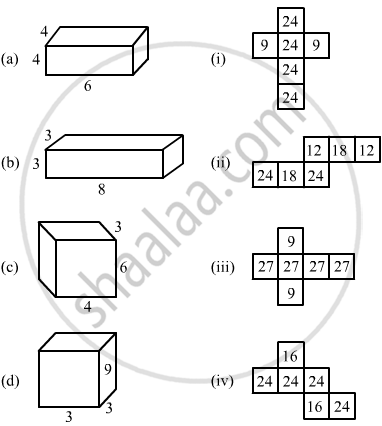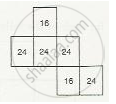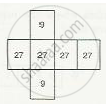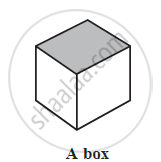Advertisements
Advertisements
Question
Match the following figure:

Solution
(a) The given figure is a cuboid with sides 4, 4 and 6 units.
\[\text { Area of a rectangle } =\text { length }\times \text { width}\]
\[ \therefore \text{Area of the rectangular face sith sides 4 and} 4 =4 \times 4=16\]
\[\text { And, area of the other face with sides 4 and 6 }=4 \times 6=24 \]
Thus, the net for the given figure will have four faces with area 24 and two faces with area 16.
Observe net (iv) satisfies this.
Thus, the net of figure (a) is net (iv).

(b) The given figure is a cuboid with sides 3, 3 and 8.
\[\text { Area of arectangle }=\text { length }\times \text { width }\]
\[\therefore \text { Area of the rectangular face sith sides 3 and 3 =3 }\times3=9\]
\[\text { And the area of the other face with sides 3 and 8 } =3\times8=24\]
\[\text { Thus, the net for given figure will have four faces with area 24 and two faces with area 9 }.\]
\[\text { Observe that net (i) satisfies this}.\]
\[\text { Thus, the net of figure (b) is net } (i).\]

(c)The given figure is a cuboid with sides 3, 4 and 6.
\[\text { Area of a rectangle }=\text { length }\times \text { width }\]
\[ \therefore \text { Area of the rectangular face sith sides 3 and 4 =3 }\times4=12,\]
\[\text { Area of the rectangular face with sides 4 and 6 =4 }\times6=24\]
\[\text { And, area of the other face with sides 3 and 6 =3 }\times6=18\]
\[\text { Thus, the net for given figure will have two faces with area 24, two faces with area 18 and two faces with area 12. }\]
Observe that net (ii) satisfies this.
Thus, the net of figure (c) is net (ii).

(d) The given figure is a cuboid with sides 3, 3 and 9.
\[\text { Area of arectangle=length }\times \text { width }\]
\[\text { Area of the rectangular face with sides 3 and 3 =3 }\times3=9,\]
\[\text { And, area of the other face with sides 3 and 9 =3 }\times9=27\]
\[\text { Thus, the net for given figure will have four faces with area 27 and two faces with area 9 }.\]
Observe that net (iii) satisfies this.
Thus, the net of figure (d) is net (iii).

APPEARS IN
RELATED QUESTIONS
The given Figure are prisms or not?

The given Figure are prisms or not?

Can a polyhedron have 10 faces, 20 edges and 15 vertices?
Verify Euler's formula for the following polyhedron:

Using Euler's formula find the unknown:
| Faces | ? | 5 | 20 |
| Vertices | 6 | ? | 12 |
| Edges | 12 | 9 | ? |
Verify Euler’s formula for the table given below.
| Faces | Verticles | Edges |
| 10 | 6 | 12 |
Using Euler’s formula, find the unknowns.
| Faces | Vertices | Edges |
| ? | 6 | 14 |
Using Euler’s formula, find the unknowns.
| Faces | Vertices | Edges |
| 8 | ? | 10 |
Using Euler’s formula, find the unknowns.
| Faces | Verticles | Edges |
| 20 | 10 | ? |
The corners of solid shapes are called its ______.
